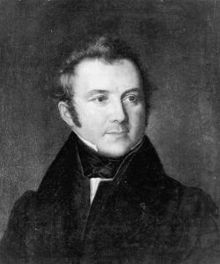Pietro Nobile

Pietro Nobile was an Italian Neoclassicist architect and builder born in Capriasca, Svizzera, 11 November 1774 – Vienna, Austria, 7 November 1854. He is regarded as one of the most prominent architects of the late classicism in Vienna and the leading architect of the Habsburg court.[1] His father moved the family to Trieste where the young Pietro attended school. He continued to be educated in Rome by Antonio Canova between 1801 and 1806.[2]
In 1807 he was appointed engineer office for construction in charge of Trieste, Istria, Aquileia and Gorizia. In 1810 he was officially appointed chief engineer for construction of bridges and roads in the Illyrian coast in Istria. He designed the coastal road from Koper to Pula, made new plans, sketches and drawings of monuments such as the Pula Arena, the Temple of Augustus and the Arch of the Sergii.[3] He also designed St. Peter's Church standing on Tartini Square in Piran, Slovenia. For the protection of monuments in Pula he did more than anyone else before him.
In 1819 he became head of the department of architecture at the Vienna Academy. His grave is located in Vienna's Zentralfriedhof (section 14 A, No. 46 A), transferred from St. Marx Cemetery. In 1894, Vienna Penzing (14th District) and Rudolf Fünfhaus (15th District), and the Nobilegasse were named after him.
References
- ^ Woermann, Karl (1925). Historia del arte en todos los tiempos y pveblos, Volume 6 (in Spanish). Editorial "Saturnino Calleja" s.a.,. p. 287.
{{cite book}}: CS1 maint: extra punctuation (link) 36202871 - ^ Casotti, Maria Walcher (1967). L'architettura a Trieste Dalla Fine Del Settecento Agli Inizi Del Novecento (in Italian). Udine: Del Bianco. p. 21. OCLC 877913
- ^ Brandanovič, Marijan. The State Archives in Rijeka Pietro Nobile Collection as a source of research of the appearance of Istrian settlements in the early nineteenth century (PDF). University of Rijeka, Faculty of Philosophy, Art History Department. p. 1.
- Attribution
- This article is based on the translation of the corresponding article of the German Wikipedia. A list of contributors can be found there in the History section.
48°08′59″N 16°26′29″E / 48.14972°N 16.44139°E
